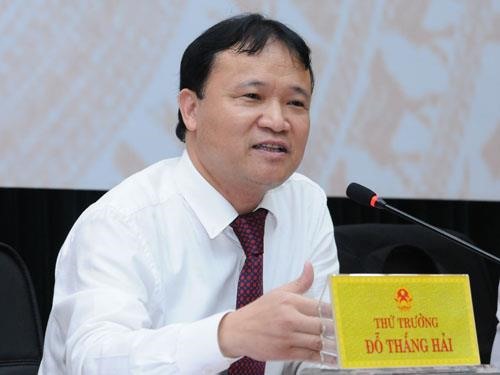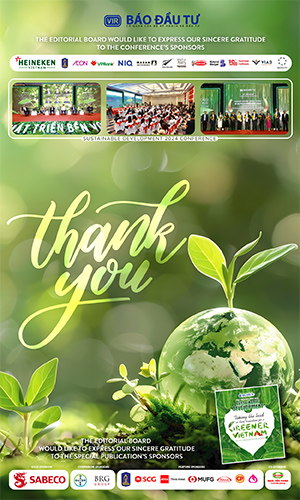Structural export sector changes will continue
 |
| Deputy Trade and Industry Minister Đỗ Thắng Hải |
The nation achieved a year-on-year export surge of 21.1 per cent to US$213.77 billion in 2017, including $19.3 billion in December. What made this impressive achievement possible?
In the beginning of 2017, the Ministry of Industry and Trade forecast a total national export value growth of 6-7 per cent over the previous year, because complicated and unpredictable developments were set to continue in the region and the world.
In this context, the surprising growth of 21 per cent was partly due to efforts of the business community and the Government’s efforts to resolve difficulties and create favorable conditions for production and business activities.
The strong export growth was also the result of correct policies initiated by the Party, the direction and management of international economic integration by the Government, especially in joining free trade agreements. The Government acted strongly to improve the investment and business environments and to attract foreign direct investment.
The global economic recovery also helped, with strong growth seen in the US, the European Union, Japan, China, India and Russia, pushing up demand in the world market. As a result, many of our export products gained in export volume as well as value.
2017 was the second consecutive year that Việt Nam gained a trade surplus. How will this affect economic development in the future?
The good results of the import and export activities in 2017 have created favourable conditions for development of international trade in particular and national economic growth in general. The trade surplus will help stabilise the macro economy and exchange rates, and control inflation.
The trade surplus shows that Việt Nam has started to produce materials for production. In 2017, the textiles, garments and footwear industry actively produced raw material in Việt Nam and even exporting it. The export value of fiber for textiles reached $3.56 billion in 2017, a year-on-year increase of 21.5 per cent.
However, in general, the support industry for many industries has still not developed to produce enough quality products to join supply chains of products and components for export enterprises, especially foreign-invested enterprises.
In 2018 and beyond, the Ministry of Industry and Trade will strive to change the structure of export goods, focusing on goods that use advanced technology in production, and to increase the export of products made with domestic raw materials.
Last year, the foreign direct investment (FDI) sector continued to lead the export surge. What are the measures being taken to balance exports by domestic and FDI enterprises, and to connect them in export activities?
Since Việt Nam became a World Trade Organization (WTO) member in 2007 and joined free trade agreements (FTAs), the number of FDI projects in the country has increased rapidly. FDI enterprises have made important contributions to boosting exports and they occupy a large share of the nation’s total export revenues.
Specifically, export value of FDI enterprises (including crude oil) reached nearly $81 billion in 2013, accounting for 61.3 per cent of the total; and corresponding figures for 2016 and 2017 were $126.2 billion and 71.5 per cent; and $155.25 billion and 72.6 per cent.
The export growth of the FDI sector in recent years has been spurred by the State’s policies on attracting and managing foreign investment, and increasing efficiency of this investment capital.
FDI enterprises have enjoyed many advantages in producing their goods in Việt Nam and being part of the global products supply chain while. Meanwhile local companies have focused on commodities like agricultural produce, seafood, crude oil and textiles that have been very vulnerable to external shocks like price fluctuations in the world market or trade barriers in countries importing Vietnamese goods.
To boost export revenues in the future, especially for domestic enterprises, the Ministry of Industry and Trade will pay attention to solving difficulties and creating favorable conditions for business activities. It will also have policies to help local enterprises access low-interest loans and expand their export reach.
Meanwhile, the domestic enterprises should focus on improving corporate competitiveness and competitiveness of their export goods, learn new production technologies and modern management practices, building quality brands and join the global supply chain.
What export goods will Việt Nam focus on in 2018?
Last year, Việt Nam achieved positive results from import and exports in the key categories of agricultural products, seafood, fuel, minerals and processed products.
Export products of the processing industry continued to play an important role in export growth, accounting for more than 81 per cent of total exports, with value estimated at $173.5 billion, a year-on-year increase of 22.4 per cent.
Agricultural and seafood products enjoyed good growth at 16.9 per cent year-on-year to $25.9 billion.
Fuel and mineral products gained a year-on-year surge of 27 per cent in export value to $4.42 billion.
Products with high export growth included coal, crude oil, telephones and components, textiles and garments, computers, electronic products and components, vegetables, rice, chemical products, plastics products, fertilisers and steel products.
At present, the structure of export products has moved according to the 2011-2020 strategy on importing and exporting goods, which is to increase the export volume of processed products and gradually reduce that of agricultural produce, seafood, fuels and minerals.
In 2018, this structural orientation will continue. We will also try to increase exports of goods that use hi-tech methods and more domestic raw material in production.
What the stars mean:
★ Poor ★ ★ Promising ★★★ Good ★★★★ Very good ★★★★★ Exceptional
Latest News
More News
- Drawing insights from data law draft (March 27, 2025 | 15:00)
- Keys to success for science, technology, and innovation (March 27, 2025 | 13:30)
- Vietnam poised for tech revolution: insights from Cambridge expert (March 26, 2025 | 11:47)
- Cooperation advantages from US-ASEAN relations (March 25, 2025 | 08:40)
- Strong Singapore-Vietnam ties can be capitalised on (March 22, 2025 | 19:00)
- Vietnam’s economy forced to navigate rough seas this year (March 21, 2025 | 09:00)
- Slew of improvements in proposed railway rules (March 20, 2025 | 16:09)
- How businesses can avoid greenwashing plight (March 18, 2025 | 17:00)
- Draft can be more effective for seafood enterprises (March 18, 2025 | 15:09)
- A comparative investment guide to Singapore and Malta (March 17, 2025 | 18:35)













 Mobile Version
Mobile Version